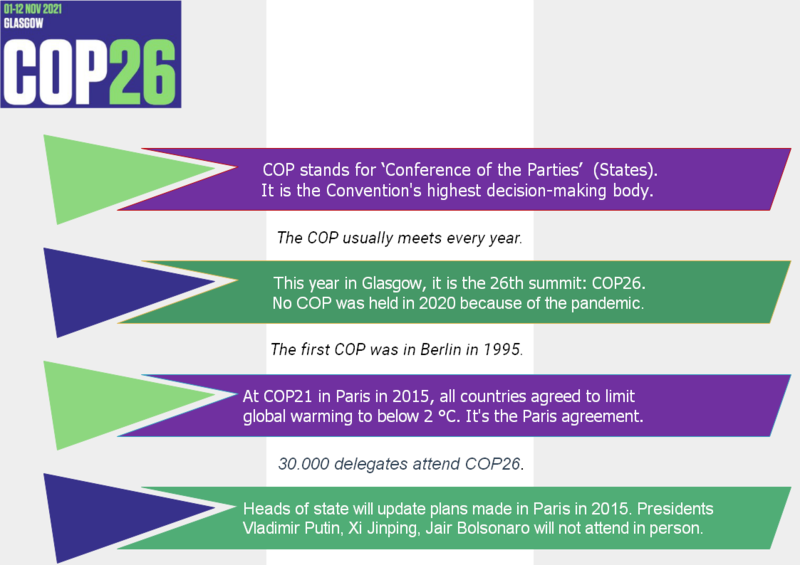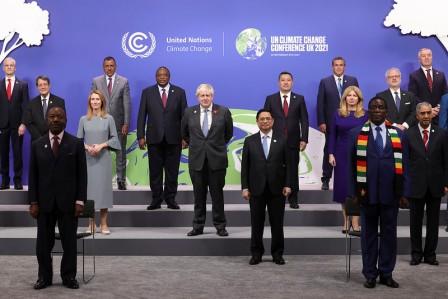Leaders et spécialistes de la planète convergent en novembre à Glasgow pour les pourparlers mondiaux sur le climat de la COP26, dont les résultats détermineront les modes d’action (ou non) des gouvernements face à la crise climatique. En voici un aperçu à travers ses protagonistes et ses thèmes. Un document explicatif rédigé par la Coalition COP26.
Trop peu, trop tard : les gouvernements n’ont jusqu’ici pas été à la hauteur, préférant la connivence des entreprises ou encore des « solutions » de mascarade sans consistance, ou qui ne prennent pas la mesure du problème, ou encore qui reposent, très souvent, sur une exploitation accrue des gens et de la planète. La COP26 se déroule à un tournant de l’histoire. À travers le monde et les mouvements, nous voyons se lever une nouvelle vague de résistance, de solidarité mondiale et d’actions locales. Nous disposons d’une occasion unique de réorganiser notre système sur des bases différentes tandis que nous sortons de la pandémie. Nous pouvons soit creuser la crise jusqu’au point de non-retour, ou bien poser les fondations d’un monde équitable subvenant aux besoins de toutes et tous.
Qu’est-ce que la COP ?
La CCNUCC (Convention cadre des Nations unies sur les changements climatiques, aussi appelée « la Convention ») a été lancée en 1992 au Sommet de la Terre à Rio de Janeiro et elle est entrée en vigueur en mars 1994. Cette Convention encadre de manière institutionnelle les efforts des gouvernements pour lutter contre le changement climatique, avec pour objectif ultime de stabiliser les émissions de gaz à effet de serre « à un niveau qui empêche toute perturbation anthropique dangereuse (induite par l’homme) du système climatique ». Presque tous les pays du monde l’ont ratifiée, devenant ainsi des « Parties » à la Conférence. La CCNUCC est aussi le nom donné au Secrétariat chargé d’assister la réponse mondiale au changement climatique. Le Secrétariat prend notamment des mesures concrètes, préparant les documents officiels pour les pourparlers sur le climat, avançant une expertise, assistant les Parties dans la mise en œuvre de leurs engagements climatiques, se coordonnant enfin avec d’autres organes internationaux pertinents. Ce Secrétariat de la CCNUCC est basé à Bonn en Allemagne et il est chapeauté par une secrétaire exécutive, Patricia Espinosa.
Le principal point à l’ordre du jour de la COP26 est la finalisation des « modalités de mise en œuvre » de l’article 6 de l’Accord de Paris, qui traite des « approches coopératives » pour lutter contre le changement climatique. À la COP25 à Madrid, aucun accord n’avait pu être trouvé sur le sujet polémique des marchés du carbone.
À la suite de la pandémie de Covid-19 et de la crise économique mondiale, de nombreux gouvernements affichent de nouvelles priorités et la COP26 s’en fera l’écho, quand bien même cet aspect ne sera pas formellement inclus dans les négociations.

Who will be at COP – and what do they do?
The official UNFCCC COP is split into a Blue Zone, for official badge-holders only, and a Green Zone, which is open to the public to visit. In theory these two spaces are linked but in practice there is very little flow of people from the Blue Zone into the Green Zone. We expect the Green Zone to be within the Glasgow Science Centre Building where the public and school groups will be able to interact with various organisations, from businesses and universities, to NGOs and international organisations. Within the Blue Zone at the Glasgow SEC there are UN officials, representatives from governments, negotiators, advisors, a lot of press and media, and organisations with ‘Observer’ status. In the second week heads of state will arrive and at COP26 we expect 196 to be present. The observer organisations are grouped into ‘constituencies’ including indigenous groups, women and gender, local government, business and industry, young people, trade unions, environmental NGOs and research NGOs. In addition to the official COP spaces there will be a Civil Society Hub that will act as a base for activists from around the world to meet and socialise. This will be open to everyone – those badged delegates of COP from global civil society and activists, both local and those who have travelled to Glasgow to add their voices to calls for global action.
How are civil society involved before and during COP?
COP needs the participation of global civil society – from putting pressure on decision makers at COP through stunts and advocacy, to building momentum in-between COPs, and providing a welcoming space to host people from around the world as they travel to the city where COP is taking place. In the UK civil society has been working hard since Glasgow was announced as the venue of COP26 to ensure people of all backgrounds can be part of the COP experience. This has included working with civil society groups in Chile and Spain to ensure the passing on of vital COP knowledge and mobilising, and the creation of a UK COP26 Civil Society Coalition to coordinate the work in the lead up to COP. This work covers areas including logistics, mobilisations (particularly the huge march expected to happen the middle weekend of COP), political strategy, Glasgow local engagement, and global solidarity. Civil society is also working with the UK and Scottish governments to create an inclusive COP and has regular information sharing meetings. Civil society and governments also work together to facilitate access to the ‘green space’ at COP26, which is the official UN area that civil society has traditionally occupied. In addition, civil society is working to create the Peoples’ Summit, an annual meeting that runs parallel to COP and brings together organisations and networks from various parts of the world to creatively share experiences, promote alternative solutions and strengthen global organisation and local action to curb the climate crisis. COP has huge potential for Scottish and UK civil society to both welcome and learn from global civil society as campaigners travel from around the world to share stories of climate impacts and to call for climate justice – there are many ways to make the most of these opportunities.
Originally published at the website of the COP26 Coalition (full version)
For further reading:
